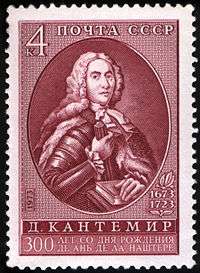Dimitrie Cantemir
Dimitrie or Demetrius[2][3] Cantemir (Romanian pronunciation: [diˈmitri.e kanteˈmir] (![]()
Dimitrie Cantemir | |
|---|---|
Dimitrie Cantemir | |
.jpg) Portrait of Dimitrie Cantemir from the first edition of Descriptio Moldaviae (1716) | |
| Born | 26 October 1673 |
| Died | 21 August 1723 (aged 49) |
| Resting place | Three Holy Hierarchs Church, Iași 47°9′35″N 27°35′5″E |
| Nationality | Romanian |
| Occupation | Encyclopedist, ethnographer, geographer, philosopher, historian, linguist, musicologist, composer |
Notable work | Divanul sau gâlceava înțeleptului cu lumea, Descriptio Moldaviae |
| Title | Prince of Moldavia |
| Term | March–April 1693 1710–1711 |
| Predecessor | Constantin Cantemir Nicolae Mavrocordat |
| Successor | Constantin Duca Lupu Costachi |
| Spouse(s) | Casandra Cantacuzino ( m. 1699)Anastasia Trubetskaia |
| Children | Matei Constantin Șerban Maria Antioh Smaragda |
| Parent(s) | Constantin Cantemir Ana Cantemir (née Bantaș)[1] |
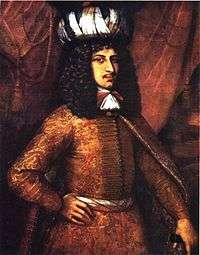
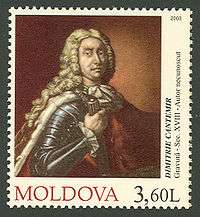

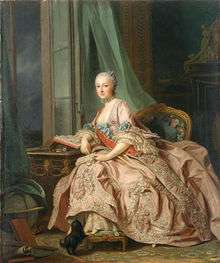
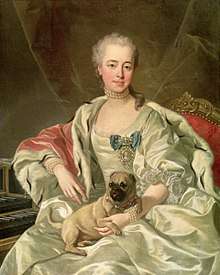
Name
Dimitrie is the Romanian form of the name Latinized as Demetrius and, less often, anglicized as Demeter.[3] The Russian form of his name was Dmitri Konstantinovich Kantemir (Дми́трий Константи́нович Кантеми́р). He is also known as Dimitri Kantemiroğlu in Turkish contexts, Dymitr Kantemir in Polish, and Dēmētrios Kantimērēs (Δημήτριος Καντιμήρης) in Greek.
Life
Dimitrie was born in Silişteni, Moldavia (now Vaslui County, Romania) on 26 October 1673[3] to Constantin Cantemir and Ana Bantăș. His elderly father was from a noble family of Crimean Tatar extraction, which came to Moldavia in the mid-17th century.[3] One of the explanations for the name "Cantemir" is that it's derived from "Can Temur", meaning "the blood of Timur", marking a direct descent from the conqueror Tamerlane.[4] His mother was a learned daughter of a local noble family. In 1685, Constantin was named voivode of Moldavia by its Turkish overlords.[3]
Although Constantin himself was illiterate, he educated his sons Dimitrie and Antioh thoroughly. Dimitrie learned Greek and Latin to read the classics as a child. One of his tutors was the scholar John Komnenos Molyvdos. Between 1687 and 1710, Dimitrie spent most of his time as a hostage or envoy in Constantinople, living in the palace he owned, where he learned Turkish and studied Ottoman history at the Patriarchate's Greek Academy. While there, he also composed Turkish music.[5]
Upon Constantin's death in 1693, Dimitrie briefly succeeded him to the voivodeship but was passed over within three weeks in favor of Constantin Duca, whose candidacy was supported by his father-in-law, the Wallachian voivode Constantin Brâncoveanu.[6] When his brother Antioh eventually succeeded to the control of Moldavia, Dimitrie served as his envoy to the Porte. During these years, he also served with distinction in the Turkish army on its campaigns.[2]
In 1710, Dimitrie was appointed voivode in his own right. Believing Ottoman Turkey to be collapsing,[2] he placed Moldavia under Russian control through a secret agreement signed at Lutsk. Then he joined Peter the Great in his war against the Turks. This ended in failure at Stănilești (18–22 July 1711) and the Cantemirs were forced into Russian exile.[7] Turkey then replaced the voivodeship with the rule of Greek phanariots.
In Russia, Dimitrie was created both a Russian prince (knyaz) by Peter and a prince of the Holy Roman Empire by Charles VI. He lived on an estate at Dmitrovka near Oryol, with a sizable boyar retinue (including the chronicler Ion Neculce). There he died on 21 August 1723, on the very day he was awarded his German title. In 1935, his remains were returned to Iași.
Family
Cantemir was married twice: to Princess Kassandra Cantacuzene (1682–1713), daughter of Prince Șerban Cantacuzino and supposed descendant of the Byzantine Kantakouzenoi, in 1699, and to Princess Anastasiya Trubetskaya (1700–1755) in 1717.
Cantemir's children were rather prominent in Russian history. His elder daughter Maria Cantemir (1700–1754) so attracted Peter the Great that he allegedly planned to divorce his wife Catherine to be with her. Upon Catherine's own ascension to the throne, however, Maria was forced to enter a convent. Cantemir's son Antioch (1708–1744) was the Russian ambassador at London and Paris, a friend of Voltaire and Montesquieu, and so influential a poet, satirist, and essayist as to be considered "the father of Russian poetry". Another son Constantin (1703–1747) was implicated in the Golitsyn conspiracy against the empress Anna and was exiled to Siberia. Dimitrie's younger daughter Smaragda (1720–1761), reckoned one of the great beauties of her time, was the wife of Prince Dmitriy Mikhailovich Golitsyn and a friend of the empress Elizabeth.
Historical Works
Cantemir was a polyglot known as one of the greatest linguists of his time, speaking and writing eleven languages. Well versed in Oriental scholarship, his oeuvre is voluminous, diverse, and original, although some of his scientific writings contain unconfirmed theories or simple inaccuracies. Between 1711 and 1719 he wrote his most important creations. In 1714, he was named a member of the Royal Academy of Berlin.
Cantemir's best-known history work was his History of the Growth and Decay of the Ottoman Empire [2] (the original title was in Latin, Historia incrementorum atque decrementorum Aulae Othomanicae[8]). This volume circulated throughout Europe in manuscript for a number of years. It was finally printed in 1734 in London and was later translated and printed in Germany and France. It remained the seminal work on the Ottoman Empire up to the middle of the 19th century; notably, it was used as a reference for Edward Gibbon's own Decline and Fall of the Roman Empire. Later scholarship contests many points owing to the dubiousness of some of Cantemir's sources.
He also published the first critical history of Romania as a whole,[3] the Chronicle of the Antiquity of the Romano-Moldavo-Wallachians (Hronicul vechimei a romano-moldo-vlahilor), from 1719 to 1722. It asserted the Latin origin of the Romanian language and the Roman origin of the people living within the former land of Dacia.[9]
Cantemir composed his Description of Moldavia (Latin: Descriptio Moldaviae)[10] in 1714[3] at the request of the Royal Academy in Berlin. Covering geographical, ethnographical, and economic aspects of Moldavia, it was similarly circulated in manuscript and only published much later. It appeared in a German geographical magazine in 1769 and was published as a book in 1771. His c. 1714 manuscript map of Moldova was the first real map of the country, containing geographical detail as well as administrative information. Printed in 1737 in the Netherlands, it formed the basis of most European maps of the country for decades.
His 1705 roman à clef A Hieroglyphic History[11] was the first Romanian novel, representing the history of the Wallachian Brâncoveanu and Cantacuzino dynasties through allegorical and mythological animals.
He also wrote an introduction to Islam for Europeans, a biography of Jan Baptist van Helmont,[12] a philosophical treatise in Romanian and Greek,[13][14][15] and an unfinished second treatise on the Undepictable Image of Sacred Science.[16][17]
Due to his many esteemed works he won great renown at the high courts of Europe. His name is among those who were considered to be the brightest minds of the world on a plaque at the Library of Sainte-Genevieve in Paris, next to those of Leibniz, Newton, Piron, and other great thinkers.
Musical Works
A few of Cantemir's roughly forty Ottoman compositions are still performed today as part of the Turkish repertoire, but his greatest service was in preserving 350 traditional instrumental pieces by publishing them in a musical notation he developed from the Ottoman Turkish alphabet in his work Edvar-i Musiki, offered as a present to Sultan Ahmed III in 1703 or 1704 and recently reprinted with modern explanations.[18] In 1999, the Bezmara ensemble recorded Yitik Sesin Peşinde ("In Search of the Lost Sound") from the Cantemir transcriptions using period instruments.[19] His compositions, those of his European contemporaries and Moldavian folk music of the period were explored on Cantemir (Golden Horn Records, 2000) performed by İhsan Özgen and the Lux Musica ensemble under Linda Burman-Hall's direction.[20] Seven of Cantemir's compositions were also featured on Hespèrion XXI's 2009 Istanbul, under the direction of Jordi Savall, with focus on Cantemir's “Book of the Science of Music”.[21]
Istanbul Museum
One of the houses inhabited by Dimitrie Cantemir during his exile in Constantinople was restored and opened as a museum in 2007.[22] It lies in Fener quarter of the walled city between Phanar College and the Golden Horn
Relations with Russians
In late 1710 Dimitrie Cantemir took the Moldovan throne with strong support from Peter the First. On 14 July 1711 Dimitrie Cantemir battled the Turks and high nobility in Stanilesti with 500 Russian cavalry troops coming to his aid. The first day showed a clear victory for the Moldovian troops, but as the days passed, a huge 72,000 army led by Pasha annihilated them and in just 4 days Moldova was occupied. Dimitrie Cantemir died in 1721 after the Persian campaign. His mark on the Russian history didn't go unnoticed, with monuments in Moscow, Saint-Petersburg, Kiev and Iasi.
See also
Notes
- "Dimitrie Cantemir". Spiritul Cantemirist (in Romanian).
- EB (1878).
- EB (1911).
- Jean Ware Nelson, The Life and the Writings of Dimitrie Cantemir (1673-1723), Prince of Moldavia, Stanford University (1955), p. 8
- Popescu-Judetz (1999).
- Lemny (2009), p. 51.
- Stoica (1919), p. 19.
- Ottoman Historians
- Moldavian description prefaced by club Măciuca Constantine , Ed. Ion Creanga , Bucharest 1978.
- Cantemir, Demetrius, Descriptio Moldaviae (in Latin)
- Cantemir, Dimitrie, Istoria ieroglifică (in Romanian)
- Cantemir, Demetrius (1709), Ioannis Baptistae Van Helmont Physices Universalis Doctrine et Christianae Fidei Congrua et Necessaria Philosophia (in Latin), Wallachia
- Cantemir, Dimitrie (1698), Divanul sau Gâlceava Înțeleptului cu lumea sau Giudețul sufletului cu trupul (in Romanian), Iași
- Cantemir, Demetrius, Le Divan ou La Dispute du Sage avec le Monde ou Le Jugement de l'Âme avec le Corps (in French)
- Cantemir, Demetrius, The Divan or The Wise Man's Parley with the World or The Judgement of the Soul with the Body
- Cantemir, Dimitrie (1700), Imaginea științei sacre, care nu se poate zugrăvi (in Romanian), Constantinople
- Cantemir, Dimitrie, Sacrosantae Scientiae Indepingibilis Imago (in Latin)
- Kantemiroğlu, Kitâbu 'İlmi'l-Mûsiki alâ Vechi'l-Hurûfât, Mûsikiyi Harflerle Tesbit ve İcrâ İlminin Kitabı, Yalçın Tura, Yapı Kredi Yayınları, Istanbul 2001, ISBN 975-08-0167-9. (in Turkish)
- In Search of the Lost Sound (album booklet). Bezmara. Istanbul: Kalan Müzik. 1999. EAN 8691834003576.CS1 maint: others (link)
- Cantemir: Music in Istanbul and Ottoman Europe around 1700 (album booklet). Lux Musica. Santa Cruz, CA: Golden Horn. 2000.CS1 maint: others (link)
- Istanbul - Dimitrie Cantemir (album booklet). Hespèrion XXI. Bellaterra: Alia Vox. 2009.CS1 maint: others (link)
- Simina, Stan. "Dimitrie Cantemir are un muzeu în Istanbul". jurnalul.ro (in Romanian). Archived from the original on 26 October 2014. Retrieved 29 July 2014.
References

- Chisholm, Hugh, ed. (1911), , Encyclopædia Britannica, 5 (11th ed.), Cambridge University Press, p. 209
- Gusterin, Pavel (2008), Первый российский востоковед Дмитрий Кантемир [The First Russian Orientalist: Dmitri Kantemir] (in Russian), Moscow, ISBN 978-5-7873-0436-7
- Lemny, Stefan (2009), Les Cantemirs: L'Aventure Européene d'une Famille Princière au XVIIIe Siecle [The Cantemirs: The European Adventure of a Princely Family in the 18th Century] (in French), Paris: Editions Complexes
- Popescu-Judetz, Eugenia (1999), Prince Dimitrie Cantemir, Theorist and Composer of Turkish Music, Istanbul: Pan Yayıncılık, ISBN 975-7652-82-2
- Stoica, Vasile (1919), The Roumanian Question: The Roumanians and their Lands, Pittsburgh: Pittsburgh Printing Co.
External links
| Wikimedia Commons has media related to Dimitrie Cantemir. |
- Greek Turkish friendship through music
- Marek, Miroslav. "Genealogy of the Cantemir family". Genealogy.EU.
| Preceded by Constantin Cantemir |
Prince/Voivode of Moldavia 1693 |
Succeeded by Constantin Duca |
| Preceded by Nicolae Mavrocordat |
Prince/Voivode of Moldavia 1710–1711 |
Succeeded by Caimacam Lupu Costachi |
